Glueless Multiple Input Multiple Output Dielectric Resonator Antenna with Improved Isolation
Abstract
1. Introduction
2. Antenna Design and Operating Principle
3. Results and Discussion
4. Conclusions
Author Contributions
Funding
Institutional Review Board Statement
Informed Consent Statement
Data Availability Statement
Conflicts of Interest
References
- Mongia, R.K.; Bhartia, P. Dielectric resonator antennas—A review and general design relations for resonant frequency and bandwidth. Int. J. RF Microw Millim. Comput.-Aided Eng. 1994, 4, 230–247. [Google Scholar] [CrossRef]
- Mongia, R.K.; Ittipiboon, A. Theoretical and Experimental Investigations on Rectangular Dielectric Resonator Antennas. IEEE Trans. Antenna Propag. 1997, 45, 1348–1356. [Google Scholar] [CrossRef]
- Luk, K.M.; Leung, K.W. Dielectric Resonator Antennas; Research Studies Press Ltd.: Baldock, UK, 2003. [Google Scholar]
- Hu, P.F.; Pan, Y.M.; Zhang, X.Y.; Hu, B.J. A Compact Quasi-Isotropic Dielectric Resonator Antenna With Filtering Response. IEEE Trans. Ant. Propag. 2019, 67, 1294–1299. [Google Scholar] [CrossRef]
- Liu, Y.; Leung, K.W.; Ren, J.; Sun, Y. Linearly and Circularly Polarized Filtering Dielectric Resonator Antennas. IEEE Trans. Ant. Propag. 2019, 67, 3629–3640. [Google Scholar] [CrossRef]
- Yang, N.; Leung, K.W. Size Reduction of Omnidirectional Cylindrical Dielectric Resonator Antenna Using a Magnetic Aperture Source. IEEE Trans. Ant. Propag. 2020, 68, 3248–3253. [Google Scholar] [CrossRef]
- Liu, S.; Yang, D.; Chen, Y.; Huang, S.; Xiang, Y. Broadband Dual Circularly Polarized Dielectric Resonator Antenna for Ambient Electromagnetic Energy Harvesting. IEEE Trans. Ant. Propag. 2020, 68, 4961–4966. [Google Scholar] [CrossRef]
- Singhwal, S.S.; Kanaujia, B.K.; Singh, A.; Kishor, J. Novel circularly polarized dielectric resonator antenna for microwave image sensing application. Microw. Opt. Technol. Lett. 2019, 61, 1821–1827. [Google Scholar] [CrossRef]
- Singhwal, S.S.; Kanaujia, B.K.; Singh, A.; Kishor, J. Circularly polarized V-shaped dielectric resonator antenna. Int. J. RF Microw. Comput. Aided Eng. 2019, 29, 9. [Google Scholar] [CrossRef]
- Hao, C.X.; Li, B.; Leung, K.W.; Sheng, X.Q. Frequency Tunable Differentially Fed Rectangular Dielectric Resonator Antennas. IEEE Antennas Wirel. Propag. Lett. 2011, 10, 884–887. [Google Scholar] [CrossRef]
- Movahedinia, R.; Sebak, A.; Chaharmir, M.R.; Ranjbar, N.M.; Kishk, A.A. X-Band Circularly Polarized Electronically Steerable Parasitic Array Radiator of DRA. IEEE Trans. Antennas Propag. 2018, 66, 721–728. [Google Scholar] [CrossRef]
- Singhwal, S.S.; Kanaujia, B.K.; Singh, A.; Kishor, J.; Matekovits, L. Multiple Input Multiple Output Dielectric Resonator Antenna with Circular Polarized adaptability for 5G Applications. J. Electromagn. Waves Appl. 2020, 34, 1180–1194. [Google Scholar] [CrossRef]
- Singhwal, S.S.; Kanaujia, B.K.; Singh, A.; Kishor, J.; Matekovits, L. Dual-Band Circularly Polarized MIMO DRA for Sub-6 GHz Applications. Int. J. Microw.-Comput.-Aided Eng. 2020, 30, e22350. [Google Scholar] [CrossRef]
- Liu, B.; Qiu, J.; Chen, L.; Li, G. Dual Band-Notched Rectangular Dielectric Resonator Antenna with Tunable Characteristic. Electronics 2019, 8, 472. [Google Scholar] [CrossRef]
- Khan, S.; Khan, M.A.; Anab, M.; Marwat, S.N.K.; Jan, N.; Ghoniem, R.M. Wideband Singly Fed Compact Circularly Polarized Rectangular Dielectric Resonator Antenna for X-Band Wireless Applications. Electronics 2022, 11, 3281. [Google Scholar] [CrossRef]
- Alanazi, M.D.; Khamas, S.K. Wideband mm-Wave Hemispherical Dielectric Resonator Antenna with Simple Alignment and Assembly Procedures. Electronics 2022, 11, 2917. [Google Scholar] [CrossRef]
- Huang, R.-Z.; Zhang, J.-W.; Zhang, C. Dual-Band Circularly Polarized Hybrid Dielectric Resonator Antenna for 5G Millimeter-Wave Applications. Electronics 2022, 11, 1761. [Google Scholar] [CrossRef]
- Ishimiya, K.; Langbacka, J.; Ying, Z.; Takada, J.I. A compact MIMO DRA antenna. In Proceedings of the International Workshop on Antenna Technology: Small Antennas and Novel Metamaterials, Chiba, Japan, 4–6 March 2008; pp. 286–289. [Google Scholar]
- Ishimiya, K.; Ying, Z.; Langbacka, J. A compact MIMO DRA for 802.11n application. In Proceedings of the IEEE Antennas and Propagation Society International Symposium, San Diego, CA, USA, 5–11 July 2008. [Google Scholar] [CrossRef]
- Singhwal, S.S.; Matekovits, L.; Kanujia, B.K.; Kishor, J.; Fakhte, S.; Kumar, A. Dielectric Resonator Antennas: Applications and Developments in Multiple-Input, Multiple-Output Technology. IEEE Antenna Propag. Mag. 2022, 64, 26–39. [Google Scholar] [CrossRef]
- Faiz, A.M.; Gogosh, N.; Khan, S.A.; Shafique, M.F. Effects of an ordinary adhesive material on radiation characteristics of a dielectric resonator antenna. Microw. Opt. Technol. Lett. 2014, 56, 1502–1506. [Google Scholar] [CrossRef]
- Kim, D.; You, C.; Hwang, W. Effect of adhesive bonds on electrical performance in multi-layer composite antenna. Compos. Struct. 2009, 90, 413–417. [Google Scholar] [CrossRef]
- Sarkar, C.; Guha, D.; Kumar, C. Glueless Compound Ground Technique for Dielectric Resonator Antenna and Arrays. IEEE Antennas Wirel. Propag. Lett. 2017, 16, 2440–2443. [Google Scholar] [CrossRef]
- Boyuan, M.; Pan, J.; Wang, E.; Luo, Y. Fixing and Aligning Methods for Dielectric Resonator Antennas in K Band and Beyond. IEEE Access 2019, 7, 12638–12646. [Google Scholar] [CrossRef]
- Sarkar, C.; Kumar, C.; Guha, D. A User-Friendly Glueless Solution for Dielectric Resonator Antennas Using a Probe-Feeding Technique [Antenna Applications Corner]. IEEE Antennas Propag. Mag. 2019, 61, 70–74. [Google Scholar] [CrossRef]
- Meher, P.R.; Behera, B.R.; Mishra, S.K. Broadband circularly polarized edge feed rectangular dielectric resonator antenna using effective glueless technique. Microw Opt. Technol. Lett. 2020, 62, 1–9. [Google Scholar] [CrossRef]
- Sharawi, M.S. Current Misuses and Future Prospects for Printed Multiple-Input, Multiple-Output Antenna Systems [Wireless Corner]. IEEE Antennas Propag. Mag. 2017, 59, 162–170. [Google Scholar] [CrossRef]
- Sharawi, M.; Hassan, A.; Khan, M. Correlation coefficient calculations for MIMO antenna systems: A comparative study. Int. J. Microw. Wirel. Technol. 2017, 9, 1991–2004. [Google Scholar] [CrossRef]
- Elshirkasi, A.M.; Al-Hadi, A.A.; Mansor, M.F.; Khan, R.; Soh, P.J. Envelope Correlation Coefficient of a Two-Port MIMO Terminal Antenna Under Uniform and Gaussian Angular Power Spectrum with User’s Hand Effect. Prog. Electromagn. Res. C 2019, 92, 123–136. [Google Scholar] [CrossRef]
- Zou, L.; Abbott, D.; Fumeaux, C. Omnidirectional cylindrical dielectric resonator antenna with dual polarization. IEEE Antennas Wirel. Propag. Lett. 2012, 11, 515–518. [Google Scholar] [CrossRef]
- Fang, X.S.; Leung, K.W.; Luk, K.M. Theory and Experiment of Three-Port Polarization-Diversity Cylindrical Dielectric Resonator Antenna. IEEE Trans. Ant. Propag. 2014, 62, 4945–4951. [Google Scholar] [CrossRef]
- Das, G.; Sharma, A.; Gangwar, R.K. Dual port aperture coupled MIMO cylindrical dielectric resonator antenna with high isolation for WiMAX application. Int. J. Microw.-Comput.-Aided Engg. 2017, 27, e21107. [Google Scholar] [CrossRef]
- Sharma, A.; Sarkar, A.; Biswas, A.; Akhtar, M.J. Equilateral triangular dielectric resonator based co-radiator MIMO antennas with dual polarization. IET Microw. Antennas Propag. 2018, 12, 2161–2166. [Google Scholar] [CrossRef]
- Guha, D.; Sarkar, C.; Kumar, C. Dielectric resonator antenna: A solution for its mount on metallic body. In Proceedings of the 2017 IEEE International Symposium on Antennas and Propagation and USNC/URSI National Radio Science Meeting, San Diego, CA, USA, 9–14 July 2017; pp. 1765–1766. [Google Scholar] [CrossRef]
- Sarkar, C.; Guha, D. Mechanically Stable No Adhesive Approach for Rectangular Dielectric Resonator Antenna: A Commercially Viable Design for Practical Applications. In Proceedings of the 2019 URSI Asia-Pacific Radio Science Conference (AP-RASC), New Delhi, India, 9–15 March 2019; pp. 1–4. [Google Scholar] [CrossRef]
- Aqeel, S.; Jamaluddin, M.H.; Khan, A.A.; Khan, R.; Kamarudin, M.R.; Kazim, J.R.; Owais, O. A Dual-Band Multiple Input Multiple Output Frequency Agile Antenna for GPSL1/Wi-Fi/WLAN2400/LTE Applications. Int. J. Antennas Propag. 2016, 2016, 9419183. [Google Scholar] [CrossRef]
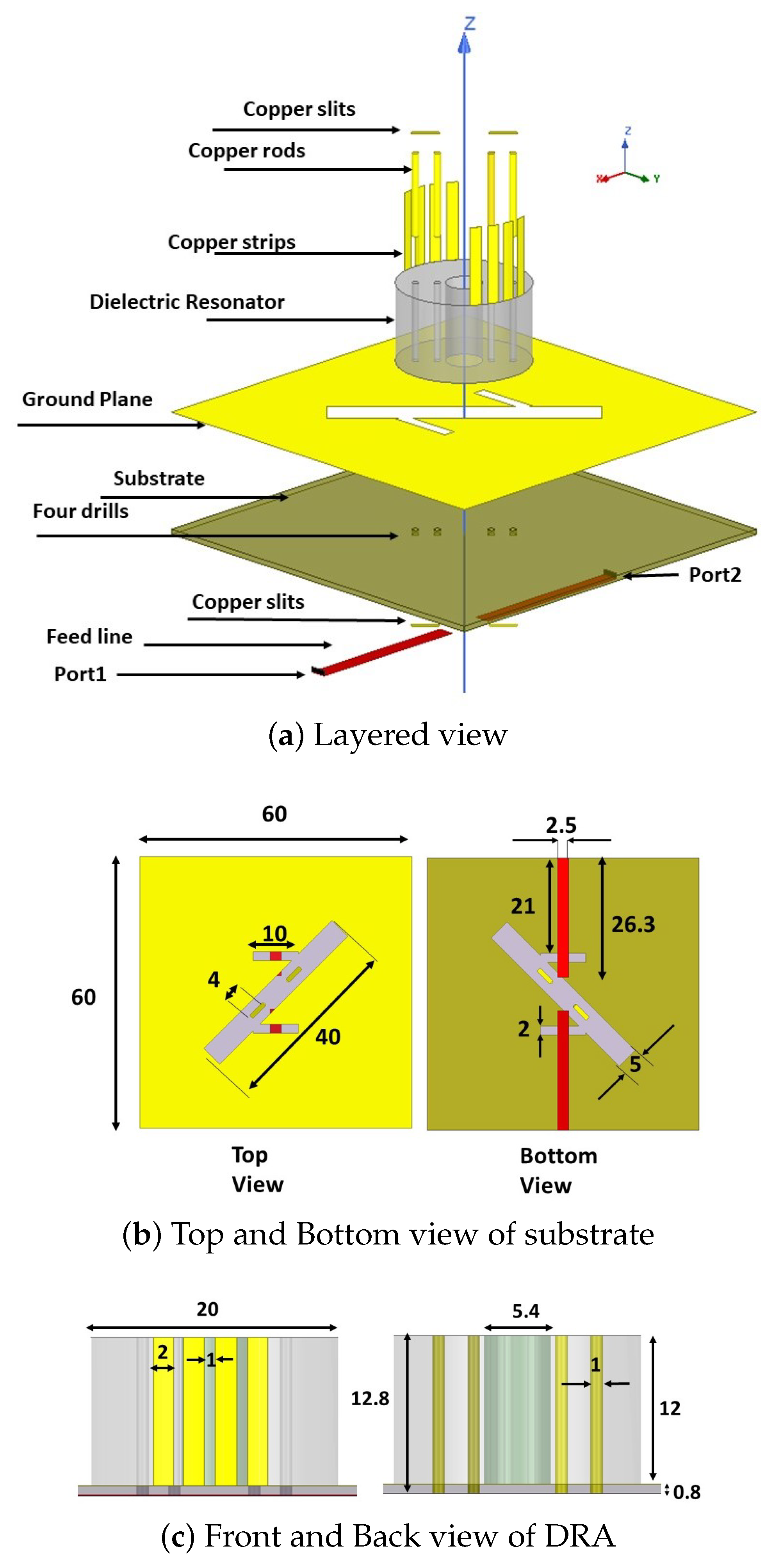

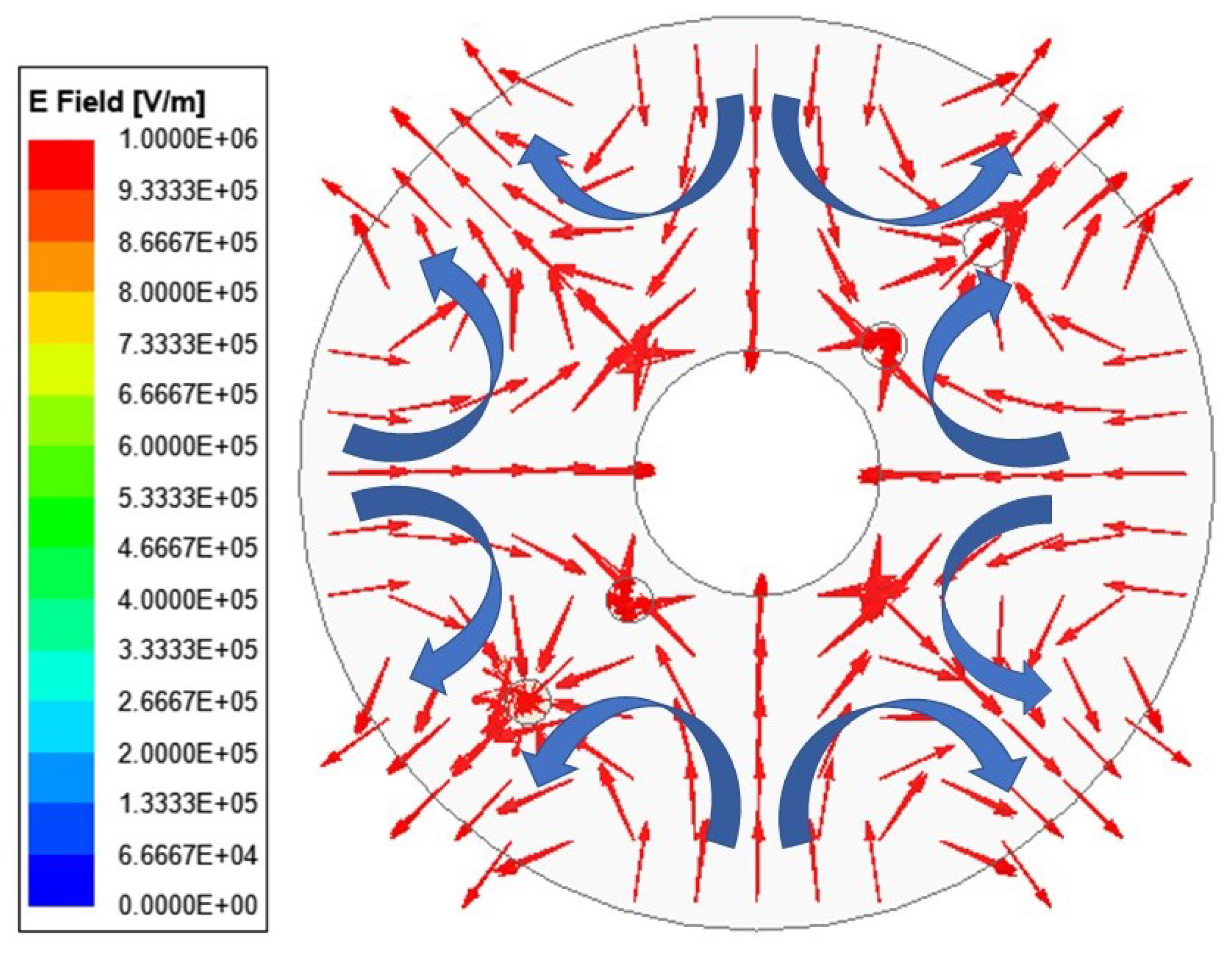
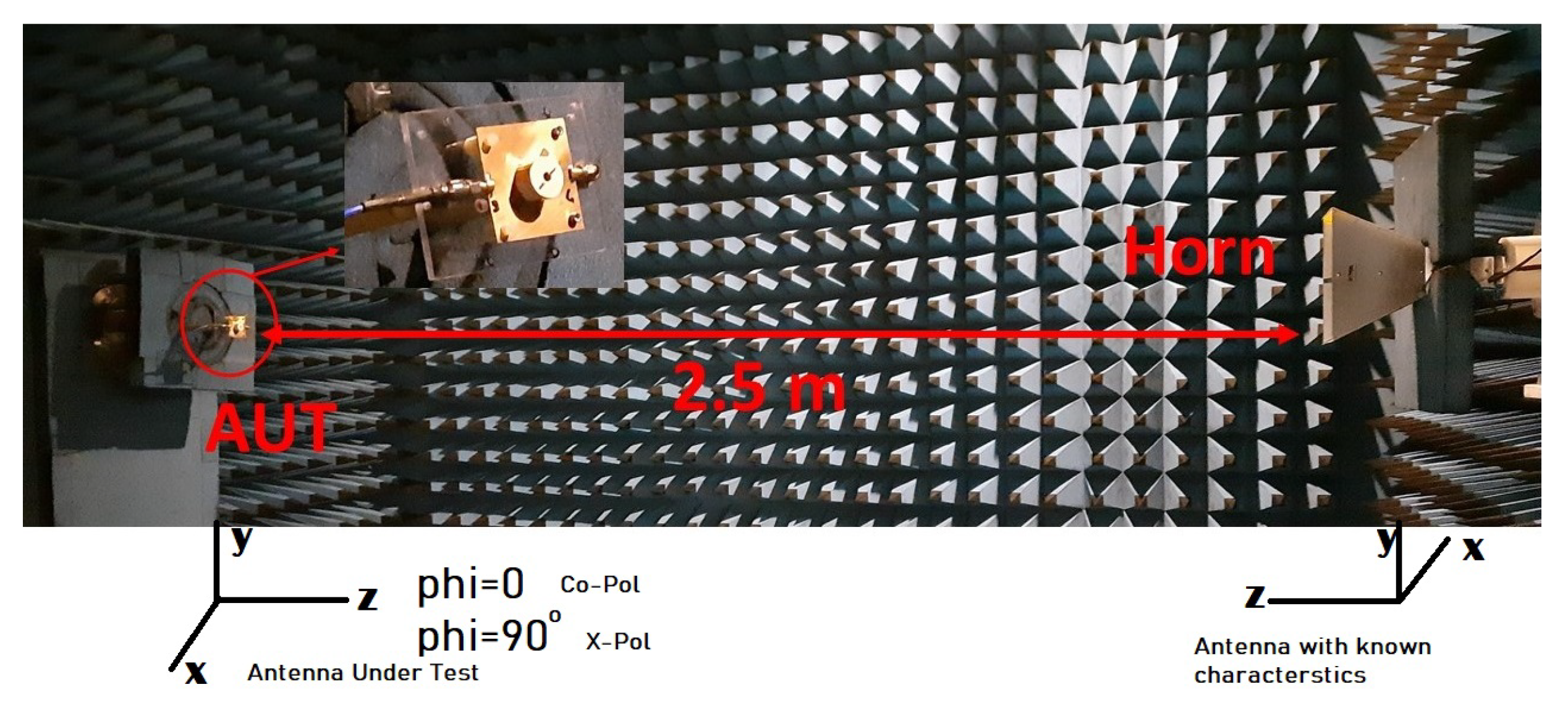
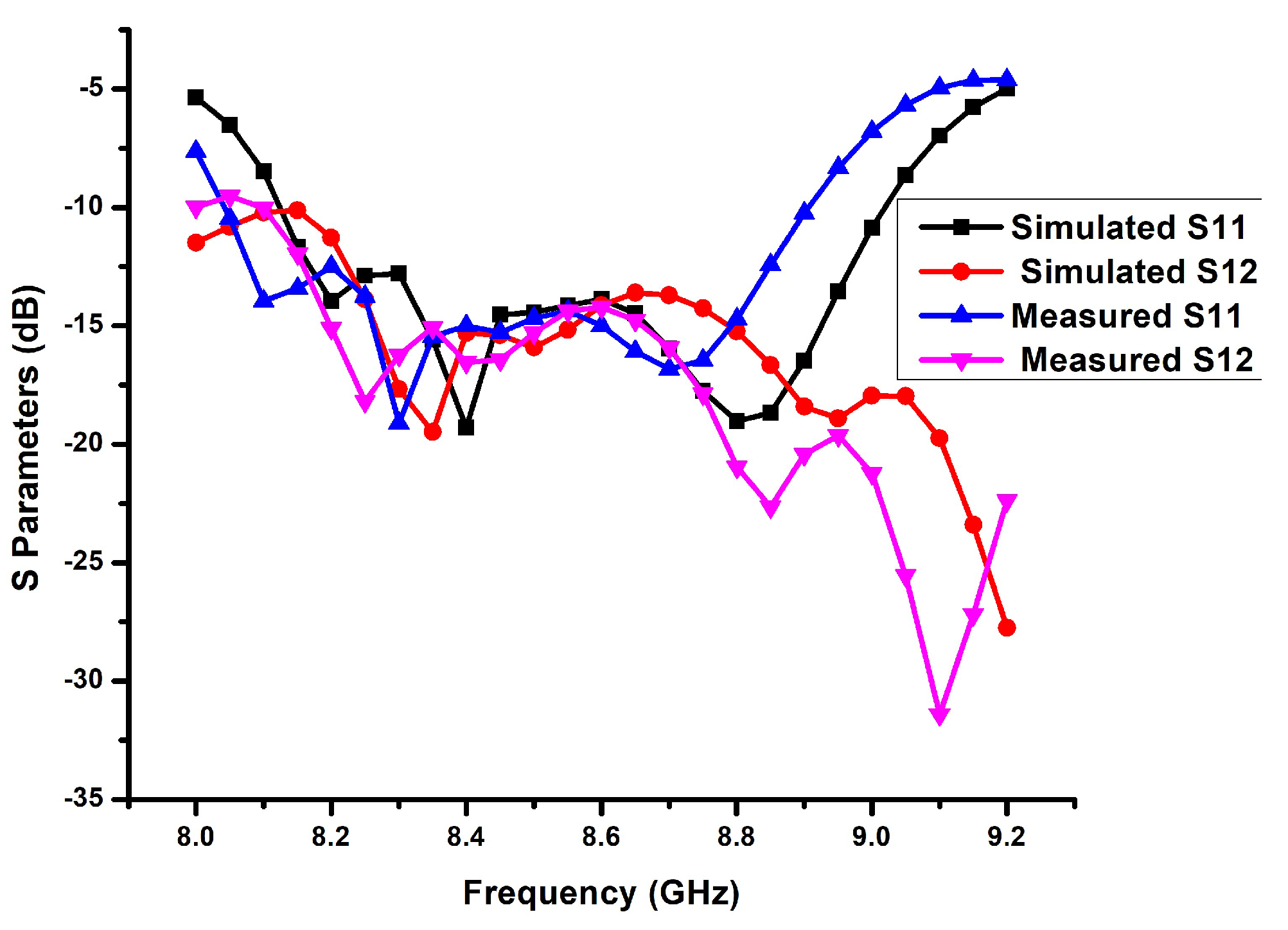



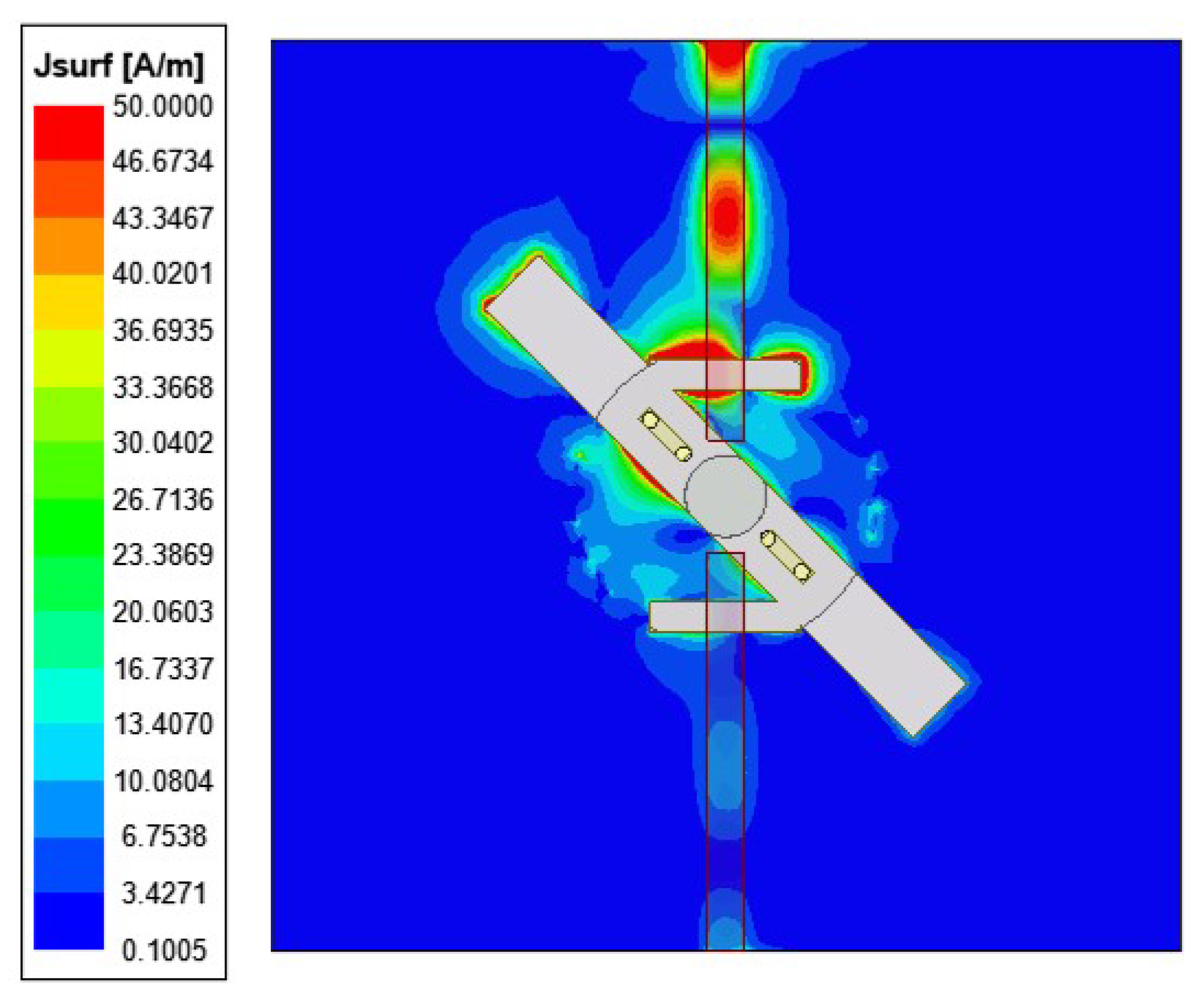
| Frequency (GHz) | 8.3 | 8.4 | 8.5 | 8.6 | 8.7 | 8.8 |
|---|---|---|---|---|---|---|
| 0.16 | 0.05 | 0.17 | 0.29 | 0.17 | 0.04 |
| Ref. | IBW (GHz) | Gain (dB) | Excitation | Isolation between Ports | No. of Ports | Glueless |
|---|---|---|---|---|---|---|
| [23] | 3.95–4.1 | 5.5 | microstrip line | not applicable | 1 | yes, groove and side pin |
| [25] | 3.95–4.1 | 6 | Probe | not applicable | 1 | yes, groove in ground plane |
| [30] | 3.78–4.07 | 5.1 | Multiple feed line | −16 | 2 | No |
| [31] | 2.4–2.51 | 2.49 | Cross aperture coupled | Not Given | 3 | No |
| [32] | 3.1–3.7 | 5.1 | Aperture coupled | −25 | 2 | No |
| [33] | 5.18–5.83 | 5.94 | Microstrip feed | −30 | 2 | No |
| [34] | 3.7–4.9 | 6 | Aperture coupled | not applicable | 1 | yes, compound ground plane |
| [35] | 3.35–3.65 | 5 | Aperture coupled | not applicable | 1 | yes, side metal clamps |
| [36] | 1.41–1.49 and 2.2–2.85 | 4.83 and 4.92 | Probe | −6 | 2 | No |
| This work | 8.2–9.02 | 6.2 | Aperture coupled | −14 | 2 | yes, thin copper rods used |
Disclaimer/Publisher’s Note: The statements, opinions and data contained in all publications are solely those of the individual author(s) and contributor(s) and not of MDPI and/or the editor(s). MDPI and/or the editor(s) disclaim responsibility for any injury to people or property resulting from any ideas, methods, instructions or products referred to in the content. |
© 2023 by the authors. Licensee MDPI, Basel, Switzerland. This article is an open access article distributed under the terms and conditions of the Creative Commons Attribution (CC BY) license (https://creativecommons.org/licenses/by/4.0/).
Share and Cite
Singhwal, S.S.; Matekovits, L.; Kanaujia, B.K. Glueless Multiple Input Multiple Output Dielectric Resonator Antenna with Improved Isolation. Electronics 2023, 12, 1125. https://doi.org/10.3390/electronics12051125
Singhwal SS, Matekovits L, Kanaujia BK. Glueless Multiple Input Multiple Output Dielectric Resonator Antenna with Improved Isolation. Electronics. 2023; 12(5):1125. https://doi.org/10.3390/electronics12051125
Chicago/Turabian StyleSinghwal, Sumer Singh, Ladislau Matekovits, and Binod Kumar Kanaujia. 2023. "Glueless Multiple Input Multiple Output Dielectric Resonator Antenna with Improved Isolation" Electronics 12, no. 5: 1125. https://doi.org/10.3390/electronics12051125
APA StyleSinghwal, S. S., Matekovits, L., & Kanaujia, B. K. (2023). Glueless Multiple Input Multiple Output Dielectric Resonator Antenna with Improved Isolation. Electronics, 12(5), 1125. https://doi.org/10.3390/electronics12051125







